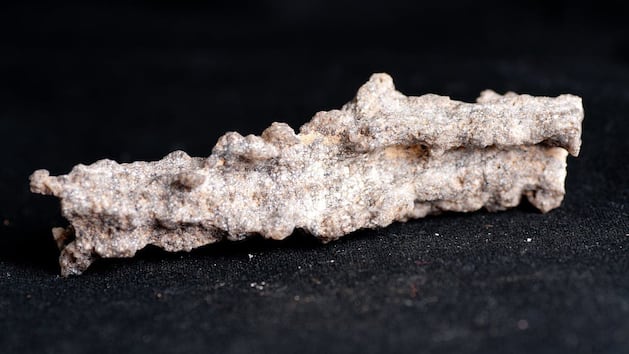One of the world’s rarest materials was formed in fused dune sands heated to more than 1700 degrees Celsius by an electrical discharge. This formed a quasicrystal – a substance in which the atoms obey an ordering principle like in a crystal, but are not strictly repeated. There are only a handful of naturally occurring—or at least non-laboratory—examples of such quasicrystals in the world. As a working group led by the geoscientist Luca Bindi from the Università di Firenze reports, they have now discovered another example of this exotic class of substances in a region in the USA known as the Nebraska Sandhills. According to their publication in the journal PNAS, the piece, just a few micrometers in size, was formed in the wall of a fulgurite – a tube of caked and fused sand created by extremely strong currents such as a lightning strike.
While normal crystals consist of groups of atoms that can be lined up indefinitely, the groups of atoms in the quasicrystal are ordered as in a crystal, but they cannot be arranged as regularly because of their special symmetry properties. Quasicrystals are so rare because atoms prefer to arrange themselves in the form of “real” crystals – or, like in a glass, simply do not adhere to any particular order. Only under special circumstances, such as extreme pressure or temperature conditions, do the structures of the quasicrystals, which are regular but not ordered over long distances, form. For example, one of these exotic minerals was found in a meteorite, another was formed in a nuclear explosion.
However, the quasi-crystal tracked down by Bindi and his team is exotic even among its kind. Most known quasicrystals have a five-fold symmetry, while the substance found in the dune with the molecular formula Mn 72.3 Si 15.6 Cr 9.7 Al 1.8 Ni 0.6 has an unusual twelve-fold symmetry. Its chemical composition also suggests that its origin is not entirely natural. Bindi’s team reports that the molten sand contains traces of metal. This is from a nearby power line that is believed to have been destroyed in the same storm that struck the dune.
The metals manganese, chromium, aluminum and nickel contained in the quasicrystal probably come from a molten fragment of the power line. Only silicon comes from the quartz of the sand grains. In fact, the team can’t say for sure if it really was lightning that created the melting tube in the sand—or if it was the power line itself that set off the discharge.
Street dog Sammy was supposed to be handed over to his new owner at Munich Airport. But the six-month-old four-legged friend escaped. The search for him, which lasted more than a week, is now coming to a happy end.
In his autobiography “Spare” Prince Harry once again unpacks about his family. So far, as usual, she has been very silent. But public reluctance is deceptive. Position is taken in the background.
The original of this post “Lightning creates one of the rarest substances in the world” comes from Spektrum.de.








